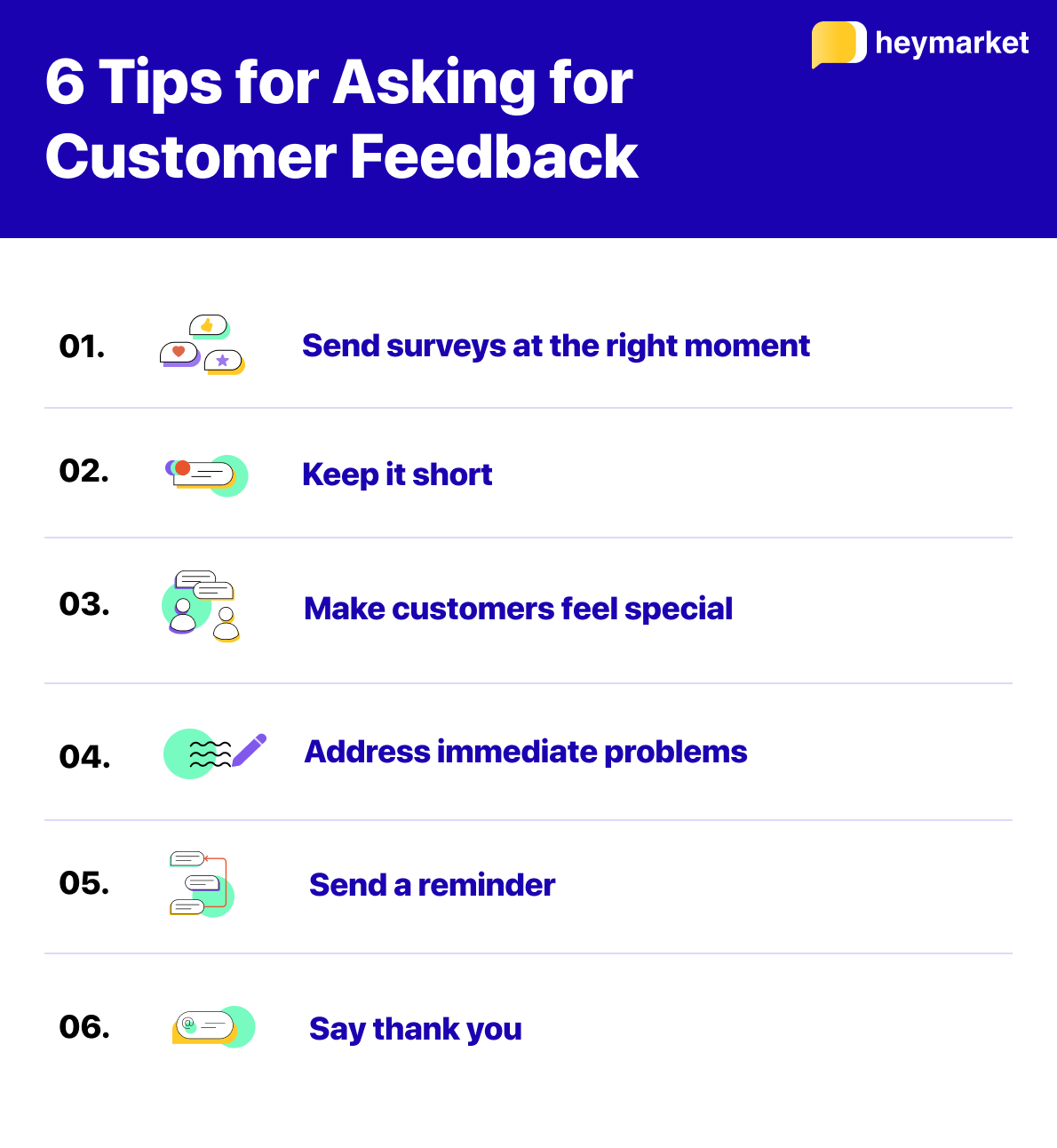
Creating a frictionless, engaging, and service-centric customer experience must be a priority for any business hoping to be an industry leader. In fact, 87% of business leaders consider customer experience the top source of growth for their brands.
However, improving the customer experience can be a challenge as technology and customer expectations continually change. Less than one-third of brands feel like they’re prepared to improve this aspect of their business.
If you want to improve your customer experience, there’s one clear place to start. You need to learn about your customers’ experiences, perspectives, and struggles with your current experience. In other words, you have to get customer feedback. Then, you can analyze it and make changes to your current processes.
In this quick guide, we’ll explore:
What Can You Do with Customer Feedback?
If you understand how to use customer feedback, it’ll be easier to decide on the method you use to gather it. Customer feedback is so important—and widespread—today that some say we are currently living in a feedback economy.
Customer feedback helps you understand how customers feel about your business. You can collect feedback on nearly every aspect of your customer experience and products or services. Depending on what you need the feedback for, you can ask customers for feedback on specific business aspects, like your return experience, or more general business aspects, like your overall customer experience.
Once you know how customers feel about your brand, you can get to work. Customer feedback empowers you to:
- Address service issues with individual customers, turning brand detractors into loyalists
- Pinpoint processes, products, or types of content that need improvement
- Inform business decisions
- Track improvements after making changes
Carefully analyzing and responding to feedback helps you improve your processes, products, and content. It shows your customers that you genuinely care about them while giving you the tools you need to boost your brand reputation.
4 Ways to Collect Customer Feedback
Most of the tools you use to connect with customers also empower you to send surveys. There are also tools that can help you track unsolicited customer feedback across third-party review sites and social media. Here are four popular tools your brand might consider using:
Send a Chat-Based Survey
Conversational commerce is a new trend led by customers. They want to be able to do all of their shopping on a single channel—messaging. Chat-based surveys allow you to send automated CSAT surveys within existing messaging conversations. With this tool, customers can share their opinions without leaving their favorite messaging apps.
Chat-based surveys have three parts, which your team can write:
- An opening question, asking customers to rate your service with a number
- A follow-up question, asking customers to respond with an open-ended answer
- A closing message, typically thanking customers for their participation
These surveys are both automated and dynamic. The follow-up questions change based on how customers respond to the opening question. Plus, if customers answer the opening question with a word instead of a number, your team will be alerted immediately so you can offer in-the-moment support.
Email a Survey
Email is still the most common channel for sending surveys. It’s a logical choice; most leads and customers have email addresses, and many of them provide their email addresses when they place orders.
There is a lot of room for variety with the surveys you might send through email. For example, you could send:
- A customer satisfaction (CSAT) survey
- A net promoter score (NPS) survey
- Visual rating surveys (e.g., with smiley and frowny emojis)
However, keep in mind that customers constantly receive email feedback requests. Their email inboxes are already full with similar requests—and in many cases, they’re ignoring them. Test and iterate your emails to ensure they cut through the inbox clutter: optimize subject lines, sender name, images, copy, and how you’re personalizing your feedback requests.
Add In-App or Website Surveys
In-app or website surveys have one big source of appeal for leads and customers. They’re located right where they are online, making them convenient to complete with a simple click or tap. Plus, you can get a snapshot of what leads and customers are experiencing while they’re actively on your website.
You can place these surveys on:
- App home pages (for long-term app users)
- Checkout pages (post-checkout)
- Content pages
If you place in-app or website surveys on pivotal pages, customers are more likely to take the leap and give feedback. Keeping these surveys particularly brief increases your chances of a high response rate. Plus, customers aren’t likely to be tired of seeing them since they haven’t been popular survey channels in the past.
Monitor Social Media and Online Reviews
You don’t have to learn how to get customer feedback online. They’ll give unsolicited, free feedback on social media (e.g., Twitter and Facebook) and online review sites (e.g., Yelp and Google My Business). This kind of unsolicited feedback is especially important, as it’s geared towards other customers who might be interested in your brand.
You can collect and track this kind of online feedback by:
- Manually combing though social media and review sites for comments, mentions, and reviews
- Relying on a feedback tool to track comments, mentions, and reviews
- Using a customer sentiment analysis tool to identify and alert you to particularly timely comments, mentions, and reviews (e.g., a disgruntled customer comment)
Using a customer sentiment analysis tool can be especially helpful when you’re gathering online feedback. These tools can notify you when a customer seems particularly upset about an aspect of your brand, empowering you to quickly address their problem.
Asking for Feedback: 6 Quick Best Practices
Choosing the right channel is just the first part of asking for feedback. You need to make sure your requests appeal to leads and customers. Here are six tips for getting more customers to respond to survey requests.

Send Surveys at the Opportune Moment
It’s important to send surveys at the right moment. Experts say that if you want feedback on a specific experience, sooner is better. For example, send leads or customers surveys about their customer service tickets within an hour of ticket resolution so the experience is fresh in their minds. Send long-term customers NPS surveys after they’ve made two or more purchases. Being thoughtful while deciding when to send which survey types to whom will help you get the most reliable data possible.
Keep It Short
In a survey, 60% of U.S. adults said they sometimes felt too busy to enjoy life; 12% said they felt this way all or most of the time. In other words, customers are too busy for long surveys. They’re a lot more likely to respond if it’s short and clear. Include the least amount of questions you can, and ensure they are very clear. In addition, proofread your feedback request. Errors in grammar and syntax can confuse survey respondents, leading them to abandon the survey entirely.
Make Customers Feel Special
Your customers want to know that you genuinely care about their opinions. In your request, highlight the fact that you value their opinions. Let them know what you’re going to do with their feedback. For example, if you’re planning a new product release that will be swayed by customer responses, let them know. That way, they’ll understand that their feedback will have a real impact.
Address Immediate Problems
When customers leave negative social media comments or reviews, it’s important to address them quickly. If you can, you should take action and fix their problem. Fast responses can help boost your brand’s reputation. Eighty-nine percent of consumers say they are very likely to use a business that responds to all of its online reviews.
Send a Reminder
Sometimes customers want to complete your survey but forget about it. (They’re busy, remember?) Send a single reminder after you send out the initial survey. About 10% of respondents reply after they’ve been sent a reminder. That being said, don’t send more reminders after that. Customers who don’t plan on responding can become annoyed if you send multiple requests.
Say Thank You
Again, customers want to feel valued by your brand. Make sure they know how much you appreciate them taking the time to provide feedback. Send a simple, genuine thank-you note after they submit their survey responses. (Consider automating these thank yous so your team never forgets this important step!)
The Bottom Line: How to Get Feedback from Customers (and Use it, Too)
Throughout the process of collecting feedback, you need to prioritize the customer. After all, they’re doing you a huge favor by sharing their feelings about your products and experience. In the long run, this information will help you improve your brand and grow your business.
When you’re choosing the channel to send your survey requests through, think about where customers are and which channels they prefer. For example:
- If your leads and customers tend to submit questions via messaging, send chat-based surveys
- If your leads and customers tend to use the web chat on your website or app, send website or in-app surveys
- If your leads and customers tend to email their questions, send email surveys
Consider how you write your surveys and your survey requests, too. Keep your customers’ busy schedules in mind. Include only a few questions and say thank you. Plus, when you’re reviewing feedback, address any immediate problems and take big-picture ideas into consideration. Fast responses to negative feedback can turn detractors into supporters.
Centralizing customers while planning how to collect their feedback and take action on it will help you achieve your ultimate goal: improving the overall customer experience.
Want to learn more about chat-based SMS surveys? Find more articles in our blog.




